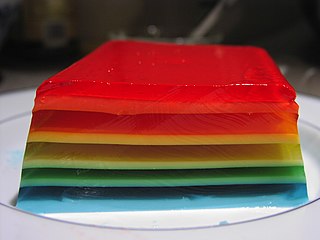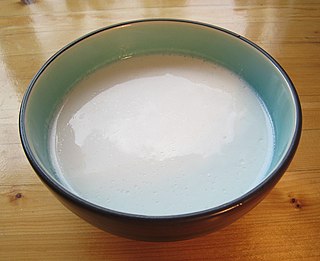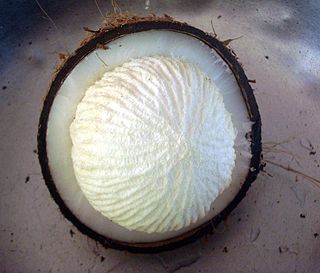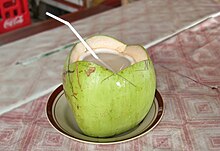
Gelatin desserts are desserts made with a sweetened and flavoured processed collagen product (gelatin), which makes the dessert "set" from a liquid to a soft elastic solid gel. This kind of dessert was first recorded as jelly by Hannah Glasse in her 18th-century book The Art of Cookery, appearing in a layer of trifle. Jelly recipes are included in the 19th-century cookbooks of English food writers Eliza Acton and Mrs Beeton.

Orange juice is a liquid extract of the orange tree fruit, produced by squeezing or reaming oranges. It comes in several different varieties, including blood orange, navel oranges, valencia orange, clementine, and tangerine. As well as variations in oranges used, some varieties include differing amounts of juice vesicles, known as "pulp" in American English, and "(juicy) bits" in British English. These vesicles contain the juice of the orange and can be left in or removed during the manufacturing process. How juicy these vesicles are depend upon many factors, such as species, variety, and season. In American English, the beverage name is often abbreviated as "OJ".

Chocolate milk is a type of flavoured milk made by mixing cocoa solids with milk. It is a food pairing in which the milk's mouthfeel masks the dietary fibres of the cocoa solids.

Nata de coco, also marketed as coconut gel, is a chewy, translucent, jelly-like food produced by the fermentation of coconut water, which gels through the production of microbial cellulose by Komagataeibacter xylinus.

Coconut milk is an opaque, milky-white liquid extracted from the grated pulp of mature coconuts. The opacity and rich taste of coconut milk are due to its high oil content, most of which is saturated fat. Coconut milk is a traditional food ingredient used in Southeast Asia, Oceania, South Asia, and East Africa. It is also used for cooking in the Caribbean, tropical Latin America, and West Africa, where coconuts were introduced during the colonial era.

Cranberry juice is the liquid juice of the cranberry – a fruit recognized for its bright red color, tart taste, and versatility for product manufacturing. Major cranberry products include cranberry juice, dried cranberry, cranberry sauce, frozen cranberry, cranberry powder, and dietary supplements containing cranberry extracts.

The nutrition facts label is a label required on most packaged food in many countries, showing what nutrients and other ingredients are in the food. Labels are usually based on official nutritional rating systems. Most countries also release overall nutrition guides for general educational purposes. In some cases, the guides are based on different dietary targets for various nutrients than the labels on specific foods.

Prune juice is a fruit juice derived from prunes that have been rehydrated. It is a mass-produced product that is often produced using a hot extraction method, and juice concentrate is typically produced using a low-temperature extraction method. It may be used as a dietary supplement to act as a laxative. It is also sometimes used as a flavor enhancer in tobacco products. It is an ingredient in many cocktails, such as the Purple Dragon, or Constipolitan.

Agave syrup, also known as maguey syrup or agave nectar, is a sweetener commercially produced from several species of agave, including Agave tequilana and Agave salmiana. Blue-agave syrup contains 56% fructose as a sugar providing sweetening properties.

Naked Juice is an American brand that produces juices and smoothies. The company is based in Monrovia, California and is owned by PAI Partners. The first Naked Juice drink was produced in 1983 and sold in California under the name "Naked Juice", referring to the composition of no artificial flavors, added sugar, or preservatives. Distribution has since expanded, and Naked Juice products are distributed in the United States, as well as in Canada, the United Kingdom, the Netherlands and France, among others.

Sports nutrition is the study and practice of nutrition and diet with regards to improving anyone's athletic performance. Nutrition is an important part of many sports training regimens, being popular in strength sports and endurance sports. Sports nutrition focuses its studies on the type, as well as the quantity of fluids and food taken by an athlete. In addition, it deals with the consumption of nutrients such as vitamins, minerals, supplements and organic substances that include carbohydrates, proteins and fats.
ConsumerLab.com, LLC. is a privately held American company registered in White Plains, NY. It is a publisher of test results on health, wellness, and nutrition products. Consumer Labs is not a laboratory, but contracts studies to outside testing laboratories. It purchases dietary supplement products and other consumer goods directly from public storefronts and online retailers, contracts for testing by private laboratories, and publishes reports based on the results. It primarily derives revenue from the sale of subscriptions to its online publications, which are paywalled. Other sources of revenue include a proprietary certification program, licensing fees, contents re-publication license fees, and advertising.

Buko pie, sometimes anglicized as coconut pie, is a traditional Filipino baked young coconut (malauhog) pie. It is considered a specialty in the city of Los Baños, Laguna located on the island of Luzon.

Pineapple juice is a juice made from pressing the natural liquid out from the pulp of the pineapple. Numerous pineapple varieties may be used to manufacture commercial pineapple juice, the most common of which are Smooth Cayenne, Red Spanish, Queen, and Abacaxi. In manufacturing, pineapple juice is typically canned.

Creamed coconut, also known as coconut butter, is a coconut product made from the unsweetened dehydrated fresh pulp of a mature coconut, ground to a semi-solid white creamy paste. It is sold in the form of a hard white block which can be stored at room temperature. The block is generally packaged in a sealed plastic pouch and some separation of the fat and the coconut flesh can be seen. In cookery, it is chopped into pieces or grated before it is added to dishes. By adding warm water it can be made into coconut milk or coconut cream substitutes. Adding water to creamed coconut in the ratio 5:2 gives coconut cream substitute, 5:1 coconut milk substitute.

Bodyarmor SuperDrink is an American sports drink brand owned by The Coca-Cola Company. Products launched under the brand include: Sports, "Lyte" Sports, "Edge Sports," and "SportWater".

Samalamig, also known as palamig, is a collective term for various Filipino sweet chilled beverages that usually include jelly-like ingredients. They come in various flavors, and are commonly sold by street vendors as refreshments. Typical ingredients of the drinks include gulaman (agar), sago pearls, kaong, tapioca pearls, nata de coco, and coconut. They are usually anglicized as pearl coolers or pearl and jelly coolers.

Sprouted coconuts, also referred to as coconut sprouts, are the edible spherical sponge-like cotyledons of germinating coconuts. They have a crunchy watery texture with a slight sweetness. They are eaten in coconut-growing countries either as it is or as part of various dishes. They are not commercially produced. They are also known variously as coconut pearls, coconut embryos, coconut candy, coconut apples, coconut cotyledons or simply coconembryos or coconapples.
Nata de piña, also marketed as pineapple gel or pineapple gelatin, is a chewy, translucent, jelly-like food produced by the fermentation of pineapple juice. It is a traditional dessert in the Philippines, produced since the 18th century using waste pineapple juices from the piña fiber industry in Pagsanjan, Laguna. It has a sweet-sour taste and is popularly used in fruit salads, jams, ice creams, candies, and various other dishes.

The Vita Coco Company, doing business as simply Vita Coco, is an American beverage company which mainly sells coconut water. The largest brand globally in coconut/plant waters, Vita Coco has operations in 31 countries as of 2016. It is a benefit corporation. The company is owned by All Market Inc.






















